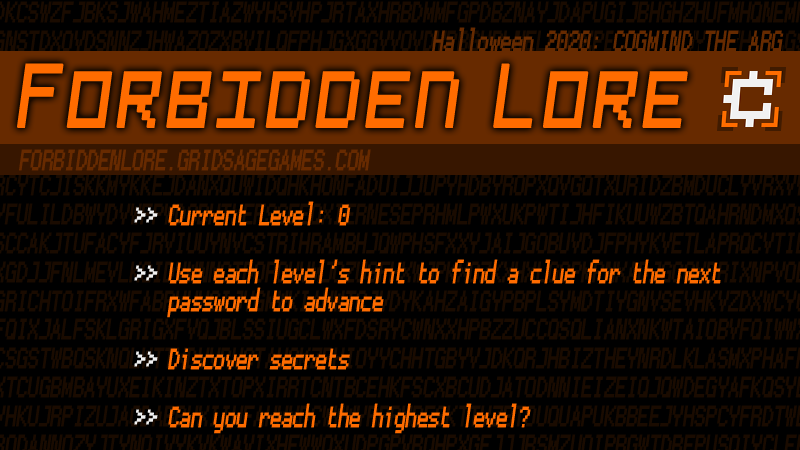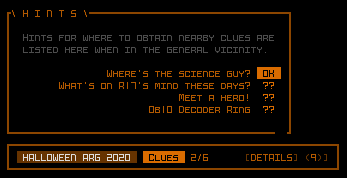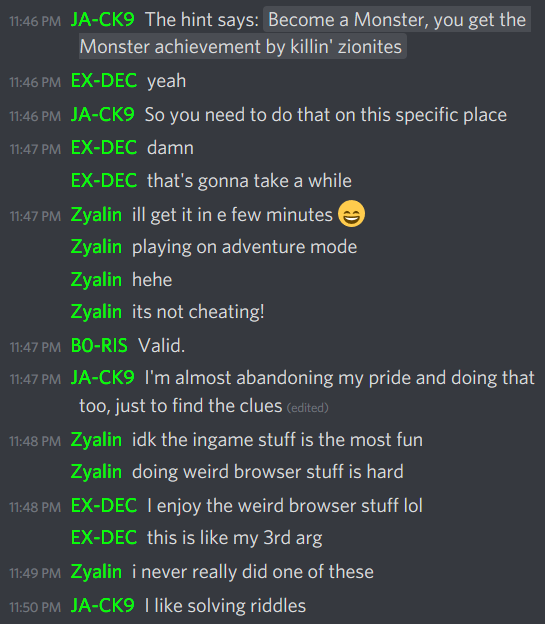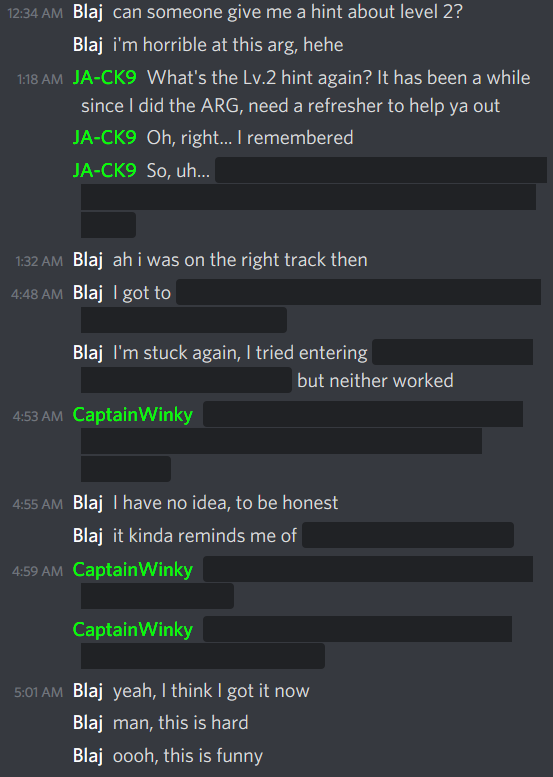A few months ago as I was planning out the rest of the year, naturally it was about time to start asking myself what kinds of special events we might have for Cogmind. The major Beta 10 was released in September, so there was once again an opportunity to spend some time playing with different ideas, and players have certainly come to expect some kind of event around various holidays given Cogmind’s history (see: Launchers, Pay2Buy, Holiday Mode, Abominations, RPGLIKE, Player 2…).
The next upcoming holiday was Halloween, but none of the specifically Halloween-themed gameplay concepts I had were particularly compelling, then one day I suddenly came up with the idea to do an ARG. I’m not really sure where this thought came from--it just popped in there xD
ARG refers to “alternate reality game,” which as a genre has a growing variety of possible forms and definitions, but among the primary uniting factors is that ARGs are created by mixing multiple types of interactive media, ideally with social aspects. (Wikipedia has lots more background info on ARGs.)
So what exactly would something of this nature work with Cogmind, and how would I build it? Having never done anything like this before, I had a ton of questions--well that’s what every special event planning session starts with, but this time it was especially acute. It really shows in my early notes, several pages of ideas bouncing all over the place, some of which aren’t even close to what the event became.
Early on I was clearly wrestling with trying to get myself into the ARG spirit by steering the concept outside the game itself as much as possible, against the grain of what I’m used to designing. I started out with REXPaint UI mockups (most Cogmind special events come with a special interactive UI component that appears in the bottom left corner, serving both as a useful reference and tool, and also providing extra info for screenshots), but in this case it didn’t seem necessary, and kinda worked against the ARG idea by concentrating more of the event inside Cogmind. Instead it would make more sense to move the primary form of interaction with this event outside the game itself.
So I built a little website.
Forbidden Lore!
Players start from that page, on which there’s a single link to reach the next page, or “level,” but doing so requires a password. Getting a password is a multistep process:
- Read a hint on the web page which suggests a place in the game world to visit, or action to perform. The hint is just that, a hint, so doesn’t constitute specific instructions, and figuring it out is to some degree a small puzzle in itself (though in most cases not usually that difficult for players relatively familiar with Cogmind).
- Find the associated password clue indicated by the hint, somewhere in game.
- Use the clue to obtain the actual password, which is somewhere on the internet. This is often the more challenging part of the puzzle, at least for a single individual, since the possibilities cover a broader range of domain knowledge, and the clues are more cryptic.
So the goal for each level is to solve a pair of puzzles to get the password to continue advancing to subsequent levels. (If you’re wondering about more details and examples, there will be plenty of those in the walkthrough I’ll be sharing later.)
Each new level provides not only the next hint, but also comes with a reward: lore! This perhaps makes the Cogmind ARG more unique than some, helping keep players interested by offering an explicit reward at every step, rather than making the solving of puzzles the only reward in itself, with maybe a single reward at the end.
A lot of Cogmind players enjoy the lore behind the game world, and there’s plenty of unwritten pieces to that lore worth introducing or expanding upon. Some pieces are already hinted at in the game’s current lore, while others are just my own additional concepts behind some of the content that the game doesn’t (or hasn’t yet!) directly addressed.
At first I had no idea at all even what theme to use for the ARG (it is “Halloween” in color only :P), but I’m glad I settled on lore since this was a fun opportunity to share more information about potential future expansions. In most cases they’re not guaranteed, but are at least fun to read and think about--I’ve reread all the entries many times myself, just thinking about the possibilities :D
Design Options
Even with a theme nailed down, there were still some important general questions to answer, like whether the event should focus on individual participation or be more of a community event.
I did want it to bring the community together in solving a set of puzzles which would be relatively difficult for any one person to complete on their own, even planning to explicitly dub it a “Community ARG,” but decided that wasn’t really necessary and it could simply be a suggestion included as part of the announcement.
I also considered offering cash prizes, but changed my mind at the last minute since that might work against the idea of encouraging general cooperation across the community. Plus time zones, the fact that this event wasn’t pre-announced at all (I wanted to surprise everyone :D) nor designed with hardcore competition in mind meant it would be hard for a cash reward to be fair to everyone. And of course there’s already lore rewards at every level, anyway!
Another big question was whether to allow for multiple paths through the ARG, completing puzzles out of order (this was especially relevant to how the website would be built). It turns out there really wouldn’t be so much content that such an approach might become very desirable, and designing for a more controlled, linear progression would make it more enjoyable overall. In the rare cases when players might discover an in-game clue before they need it, they could simply write it down for later reference.
Time to Solve
I targeted 1~2 weeks for a decent individual player working hard at it, or a month if relatively slow, but based on the amount of ARG content I figured that a group of players working together could probably do it in just a day or two.
Sure enough the first team to assemble as soon as the event started managed to reach the end in about 22 hours.
The puzzles are ordered mostly by depth, thus the first clues are found early on, and so on, making it easier to find multiple clues in the same run without having to start over. Of course with branching and a lack of backtracking in Cogmind exploration, it’d be impossible to solve the entire ARG in a single run. Theoretically one could acquire every single clue in a minimum of two runs if they happen to have the right branches spawn in the proper order and choose to do certain things in each, although it’s highly unlikely someone would both get that opportunity and make the choices required, in some cases because the choices could be more dangerous and jeopardize some other clue they were aiming for at the time. More realistically it would at least take about 4~5 runs to complete (not counting potential deaths along the way).
Participation
70.5% of ARG release version (Beta 10.2) players were playing in ARG mode.
Note that Cogmind stat uploading is opt-in, so data only includes a subset of the community, and this event in particular had a higher run requirement threshold than previous events, at 10 runs instead of 3. What that means is that the event only auto-activates once a player has logged at least 10 prior Cogmind runs. Events normally exclude beginners like this in order to avoid confusing them (alternative rulesets and content are basically being added for experienced players to try out, or at least those already somewhat familiar with the base game). Players who hadn’t yet met that threshold could still manually activate it, but according to the data only one player chose to do that.
This event in particular, with its deep lore rewards and requirement that one already be pretty familiar with the world in order to make good progress, was very much aimed at long-time players, and the median historical run count among participants was 40.
9.7% of players who met the threshold to automatically activate ARG mode decided not to and forced the mode off in order to play the regular game. (Some other players and runs were also excluded from the 10.2 ARG because they had manually activated some different past special event.)
The median number of ARG runs per participant was 3, which isn’t really enough to solve it to the end, although in some cases where people were working together they might only do one run for the team.
Honestly the overall data here is not incredibly useful because it doesn’t offer a way to know who was actively playing the mode with the intent to participate, because again it activates automatically for most players. Unlike how I’ve handled most previous events, I didn’t include any mode-specific scoresheet data for analysis this time around.
But! We do happen to have another metric which will be somewhat more accurate, and also include anonymous players who didn’t opt in to data uploading. It just so happens that anyone who gets the first hint and is on their way to completing the first level of the ARG has to visit a particular Pastebin paste, and that page has a unique hit counter. The paste itself is unlisted, so it’s mostly going to be visited by players who are participating. Looking there (and subtracting my own test visits to that page with various browsers :P) I can see that we’ve got 185 unique hits. Still not likely 100% accurate, but it’s a decent gauge of participation.
Apparently several dozen people also visited the account page I set up to make that post, from a special someone in the game ;)
Note the data for the above section was recorded a couple days before the end of the official ARG period (one month), so would be missing the last bit, plus some will still be playing past the end.
Architecture
The website part of the project is quite simple, a good thing because I ain’t no web dev.
Like the front page, the content of each additional page/level is simply an image containing the entire page’s text and graphics (so I can work where I’m more comfortable, in Photoshop :P), plus a hint linking to the next page.
Each new level is protected by htpasswd authentication, where as the first page indicates the user name for each level is simply “cogmind” (for simplicity), while the password is what players have to discover, as described above.
While building the site I tested all the content and links numerous times in multiple browsers to make sure there were absolutely no mistakes, since I didn’t have anyone else helping me with prerelease testing this time as I wanted the nature of the event to be a surprise for everyone (even patrons). I did another complete round of testing once again shortly before launch, just in case.
On the game side there were a few new things to build, all of it pretty simple, though.
Naturally there’s new content included with this release, basically messages in various forms, and those needed to be stored somewhere. My inclination with this sort of thing is to store all related data in a single external file, for ease of editing and organization. Doing this for an ARG, however, would make it quite easy to identify and hack, so I decided to avoid centralizing the data and instead spread it around within the executable itself.
Even there I didn’t want the text to be that easy to scrape, so I also added a new system to encrypt strings within the executable. Despite these precautions I’m sure a dedicated individual could still hack it in less than a day, but that’s fine, and could be a challenge in itself if anyone with the appropriate skills wanted to take that route to “solving” the ARG :)
The other main game-side work involved display methods for clues. This was fairly easy since sharing clues in most cases just piggybacked on the existing message systems, although in some cases it was necessary to make it a bit more obvious that something was a clue, for example the on-map alert/notice pop-up system got a new Halloween color theme option I could use for messages prefixed with “FORBIDDEN NOTICE:”. There’ll be plenty of examples of this in the later walkthrough.
Early in development I considered going the usual special event route with a dedicated interface for recording hints, listing clues and whatnot, but decided it wasn’t necessary, and would even get in the way given how the event ended up being designed.

Like raising levels during the RPGLIKE event in 2019, the mockup suggested there would a flashing popup whenever a clue was obtained, to make it extra obvious.
Puzzle Ideas
To come up with ideas for the puzzles, I first came up with two lists: one representing potential sources of clues within Cogmind, and another suggesting where I might want to hide passwords outside the game.
Most of the in-game options ended up being used, since an event like this should aim for maximum variety:
- NPC dialogue, for example on meeting them, or when they’re destroyed
- Hacking to parse an NPC (reading their mind)
- Scene text on witnessing an event
- ALERT-style global announcement
- Terminal query
- Some special cases used other more unique channels, as indicated in the walkthrough
For possible password locations I chose mostly bits of the internet over which I have some or complete control, in order to ensure the event would go according to plan, and also even continue to be accessible after the official event ended:
- The event website (a variety of things are hidden in the website itself, which seems not too uncommon for an ARG? :P)
- Cogmind run database
- r/Cogmind subreddit
- Grid Sage wiki and/or forums
- Roguelikes Discord
- This dev blog
- Pastebin
- Other websites
Not all of the above were actually used. Also note that some clues would likely require using a search engine like Google to find information relevant to uncovering a password. Passwords might also be directly provided within the game instead of via the internet, where that approach would be fun or made more sense.
As for the puzzle content itself, aside from being basically familiar with the world of Cogmind, much of it is tech-oriented. Obtaining passwords is easiest with some knowledge of very basic web page analysis, binary text, CPU hardware, a certain movie, multiple other roguelikes, specific Cogmind lore, and Cogmind achievements. Being good at using a search engine in general would definitely help a lot, and could mitigate much of the need to have these skills or knowledge prior to the event.
By the way, the terminology I’ve been using throughout this article, and that I stuck with throughout development to keep things organized, defines a “hint” as the piece of info given on the website for where the player can get more info to progress, and a “clue” being the info found in game that leads to the final answer/password which is usually found online, outside the game.
Results and Observations
Reception was pretty good. Some players had never even heard of an ARG, others said they’d done a few before and loved them, and yet others said they didn’t really like them in general. Regardless of what kind of event is held not everyone is as open to a larger departure from a game’s normal format, but some players were really excited about it and enjoyed the process.
Not everyone was interested in the same part of the event, either--some were big on the puzzle solving, but didn’t necessarily want to go through and do the in-game clue-collecting part. Even some who did want to do the collecting themselves had trouble targeting a specific location in the game during their run, since that’s not normally how they would play (and it’s overall a more challenging way to play Cogmind). And some players simply had fun watching others do the ARG to share the lore afterward.
It definitely turned out to be a community event that helped give a singleplayer game more of a multiplayer feel, because even if not in a team, often times players would need additional hints from others to fill gaps in their knowledge, or because they maybe overlooked a clue.
I had fun listening to players in the voice channel on Discord working together to advance through the ARG.
I hung out in that channel for six hours, mostly as a silent observer, as 5~8 players at a time solved level after level. The group had some of its better players responsible for quickly playing to the relevant in-game areas, while others were thinking through puzzles or alternative approaches. Puzzles that would eventually stump a lone individual for a while, or even permanently without extra hints, were no match for a group of players working together bouncing ideas off one another, and that first group was the only known one to finish in a day.
One interesting thing about hosting an ARG partially inside the game is that people pay a lot more attention to the game’s details, to the point that players were asking others “wow, was this here before?” and “is this new?” or “did you know that???,” where in every case it was something common that had been a part of the game for years--some player just hadn’t noticed that particular detail before :P
So in that sense, ARGs are apparently a good way to force players to really notice details! (relevant or not…) Of course this effect also had players trying to find lots of meaning even where there is none, both inside and [especially] outside the game, leading to a variety of wild goose chases when searching for clues. One particular clue I’ll get to later in the walkthrough was especially funny because one of the websites players needed to visit (not mine) also had its own cryptic ARG-style content embedded in the page itself, unrelated to the Cogmind ARG :P
Most of the Cogmind community plays with the default Rogue difficulty setting, but several switched to easier difficulty modes specifically to collect clues more quickly and reliably.
Starting from the second day a dedicated chat channel was set up for the ARG (day 1 would’ve been best, but at the time most participants were hanging out in the voice channel for faster communication at the start anyway). Technically the default ARG period was for the entire month of November (and some will likely continue playing beyond that), so it’s been there and receiving a trickle of new comers as time goes on, more so because I keep pointing people there when they ask related questions on other forums or elsewhere.
As far as organization goes, and seeing how players advanced through the event, in the end I still think a linear design was the best approach, though I feel it would’ve been nice to have even more “side quests,” additional ARG content to discover along the way but that wasn’t required in order to progress to the end. There were a few such secrets, but not many--two of them were discovered, and to my knowledge the third has yet to be found.
So that’s it for the background and meta discussion. In my next article I’ll be sharing a walkthrough for the ARG puzzles with lots of juicy details and commentary.





